What is Ticker Tape and How to Read it?
Have you ever heard of ticker tape in the stock market? No? Then you must read this blog.
If you are someone who wants to make a career in the stock market, then you should know about ticker tapes. It plays a pivotal role in the stock market.

What is Ticker Tape?
Ticker tape is a historical financial tool that displays stock market data in real time. It used to be a paper strip that continuously printed stock symbols, price fluctuations, and transaction volumes.
Ticker tape devices, which provided a visual picture of market action, were historically common in financial institutions.
While digital displays and electronic trading platforms have mostly replaced ticker tape machines, their historical significance cannot be understated.
History of Ticker Tapes
The invention of ticker tape can be traced back to the late 1860s, when Edward A. Callahan, a brilliant employee of the American Telegraph Company, devised the first electrically controlled stock ticker.
Callahan’s idea revolutionised financial communication by allowing stock prices to be conveyed quickly across telegraph cables. This invention predicted the ticker tape machines that were famous with stock exchanges.
The early ticker tape machines were mechanical wonders that combined engineering precision with communication speed. These machines used a paper strip to print stock symbols, prices, and trade volumes in real time.
The capabilities of ticker tape devices expanded in unison with the maturity of financial markets. Initially restricted to displaying stock prices, the technology has developed to include other data such as trade volumes and bid-ask spreads.
Ticker tape joined the digital era with the introduction of the internet. Digital ticker displays were embraced by online platforms and financial news websites, giving investors immediate access to real-time market data.
Evolution of Ticker Tapes
Over the course of a century, ticker tape has evolved to mirror the rapid advancements in communication and technology within the financial markets.
The invention of mechanical ticker tape devices in the late 1800s gave rise to the concept of ticker tape. This era began in 1867 with the introduction of the first electrically driven stock ticker by Edward A. Callahan.
These devices, which could send real-time stock prices over telegraph lines, were engineering marvels at the time. Information was conveyed by the machines via a punched paper tape method; each stock had its own symbol.
Originally, ticker tape devices solely displayed stock prices. However, as the demand for additional market data widened, the technology evolved to include more data.
This featured information such as trading volumes, bid and ask prices, and market-related news tidbits. With the introduction of computers and electronic communication, financial information could be shared more quickly and efficiently.
The physical tape was replaced with electronic ticker displays, which provided a constant flow of real-time data without the use of paper. This transformation signified a significant improvement in the speed and quality of information distribution, allowing investors to respond quickly to market changes.
The evolution of ticker tape in the 21st century has expanded to mobile devices. Ticker tape-style displays have become a typical feature on banking apps, allowing users to watch stock prices and market trends while on the go.
The widespread availability of mobile phones revolutionised access to financial information by providing individual investors the tools to monitor and manage their portfolios in real time.
How to Read Ticker Tape
Understanding ticker tape information may appear to be a secret language, but with a basic understanding, it becomes a valuable skill for investors. Here’s a breakdown of the main components:
- Stock symbol: A stock symbol is a unique sequence of letters that represents each company. For example, AAPL stands for Apple Inc., and GOOGL stands for Alphabet Inc. (Google).
- Trade price: The stock’s most recent trade price is shown, showing the value at which the previous transaction happened.
- Price change: An arrow or a plus/minus symbol indicates the price movement’s direction.
- Volume: The volume represents the number of shares exchanged. 500K signifies that 500,000 shares were traded.
- Time Stamp: A timestamp is usually included on ticker tape to indicate when the information was last updated.
Let me give you an example:
[AAPL 15K @ 1250 ^ 100]
- AAPL – It is the ticker symbol used to identify the company of whose stocks are being traded.
- 15K – It refers to the volume of trades. Which is K= 1000, M = Millions, and B = Billions. So here we can see, shares traded are fifteen thousand.
- @1250 – This is the price for which the share is being traded.
- ^ 100 – It shows the change in the direction of the price the share is traded, whether it’s trading higher or lower than the previous day. Here the symbol says that the price is higher than the previous day by Rs. 100.
Quote Priority
When reading ticker tape, understanding quote priority is critical. Not all trades occur at the same price in a rapid market. The price and time of the order dictate the order in which trades are completed, known as quote priority.
The ticker tape prioritises the best bid (the highest price a buyer is ready to pay) and the best ask (the lowest amount a seller is willing to accept).
Conclusion
While ticker tape machines may no longer dominate the financial landscape, their legacy persists in the electronic ticker displays we see today. The ability to read and interpret ticker tape remains a valuable skill for investors, providing a real-time snapshot of market activity.
As technology continues to advance, new tools and platforms emerge, but the fundamental principles of market analysis rooted in the ticker tape era endure. By understanding the language of ticker tape, investors can navigate the complexities of the stock market with greater confidence and agility.





